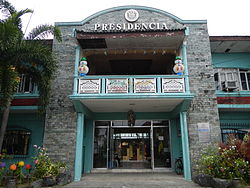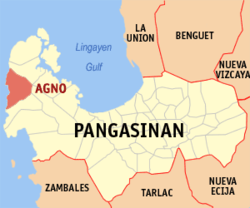Agno, Pangasinan
| Agno | ||
|---|---|---|
| Municipality | ||

Presidencia Agno Pangasinan
|
||
|
||
 Map of Pangasinan showing the location of Agno |
||
| Location within the Philippines | ||
| Coordinates: 16°07′N 119°48′E / 16.117°N 119.800°ECoordinates: 16°07′N 119°48′E / 16.117°N 119.800°E | ||
| Country |
|
|
| Region | Ilocos (Region I) | |
| Province | Pangasinan | |
| District | 1st district of Pangasinan | |
| Founded | 1791 | |
| Barangays | 17 | |
| Government | ||
| • Mayor | Jose N. Pajeta Jr. | |
| • Vice Mayor | Wilson N. Rosete | |
| • Electorate | 17,036 voters (2016 election) | |
| Area | ||
| • Total | 169.75 km2 (65.54 sq mi) | |
| Population (2015 census) | ||
| • Total | 28,052 | |
| • Density | 170/km2 (430/sq mi) | |
| Time zone | PST (UTC+8) | |
| ZIP code | 2408 | |
| 015501000 | ||
| IDD : area code | +63 (0)75 | |
| Income class | 3rd municipal income class | |
| Revenue | ₱ 7,864,320.61 (2016) | |
| Poverty incidence | 11.27 (2012) | |
| Website | www |
|
Agno is a 3rd class municipality in the province of Pangasinan, Philippines. According to the 2015 census, it has a population of 28,052 people.
The town is characterized by rolling terrain and rainfed rice fields. Near the poblacion, or town plaza, the road passes along the Mabini river or (Balincaguing River), which drains into the South China Sea further west. The town plaza is home to a centuries-old Roman Catholic church, as well as one of the first congregations of the Philippine Independent Church. The town shares borders with the town of Bani to the north, the town of Mabini and Alaminos City to the east and with Burgos to the south.
The town's main livelihood is fishing and agriculture, although a number of her sons and daughters work as doctors, physical therapist, nurses, engineers, computer programmers and accountants in numerous countries around the globe. On top of that, the town produces successful teachers, policemen and policewomen, and lawyers.
During the summer months of April and May the town's market abounds with fresh fruits such as mangoes and duhat, as well as fresh catch such as tuna, flying fish, grouper, lobsters and other seafood.
The town is home to natural attractions such as the Mabini river, the Umbrella Rocks in Sabangan, as well as several beaches, Agno Beach being the longest and most popular. There are several other beaches hidden along the coast such as the Macaboboni cove (which features a small cave) as well as a white beach in Brgy. Gayusan. To the southern end of Agno Beach, one can dive from a two-story-high rock amidst crashing waves and end up in a beautiful coral garden below.
Arthur Cabantac was the mayor of Agno from 2007 until he was shot while playing Mahjong. He was then succeeded by Jose N. Pajeta Jr, the town's vice mayor during that time.
The name Agno was derived from a species of swamp tree called “Agno Casto”, a chaste tree used for medicinal concoctions to relieve pain and illness, that grew abundantly in the locality. In time, “Agno” was retained to become the name of the town.
Agno was formally organized into municipality in 1791. During the Spanish regime and early part of the American era, Agno was part of the Province of Zambales, but upon enactment of Public Act No. 1004 dated November 30, 1903 of the Philippine Commission, the northern part of Zambales including Agno was annexed to the Province of Pangasinan.
...
Wikipedia


